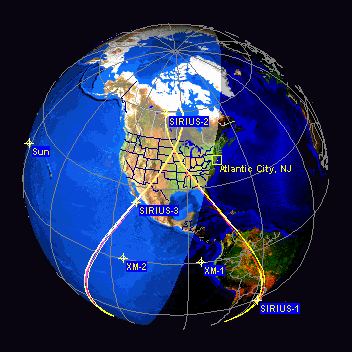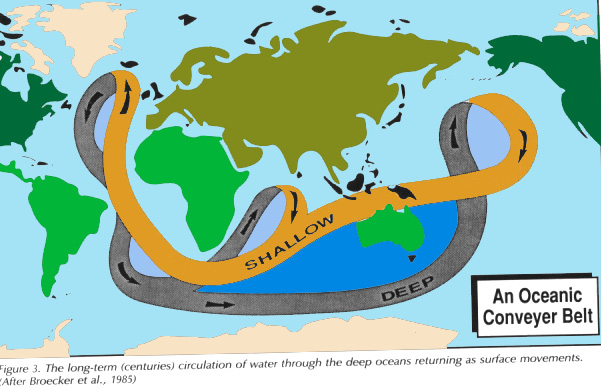Climate Change: Picturing the Science, Gavin Schmidt & Joshua Wolfe.
Notes on an overview
of their concepts, evidence, and meaning.
satellites orbiting the Earth.
Part chapters page
I Symptoms
2
Changes in the North (Arctic) 45
3
Sea Changes 73
4
Going to Extremes 95
5
The Life of the Party 113
II Diagnosis
6
Climate Drivers 135
7
Studying Climate 157
8
The Prognosis for the Climate 195
III Possible Cures
9
Getting our technological fix 213 solutions / mitigations
10
Preventative Planetary Care 251 costs, doing, politics
11
A final Note 279
p. 285, are sources
1
Taking
the Temperature of the Planet:
1500s Galileo, perfected the thermometer
The prevailing westerly winds in the northern and southern latitudes are changing by characteristic storm tracking farther north and south.
p. 27.
Less than one in a billion odds for the clustering of evidence to be a chance event,
“proxy evidence”
1. ocean sediments: radiolarians are warm water, coccolithophores are colder water – when they fall to the floor of the basin their skeletons track pervious climatic changes, silica in radiolarian mean warmer periods, calcium carbonate in coccolithophores reveal cooler periods in the geological past.
2. fossil pollen in lake sediments match the broad shifts
3. Tree ring data show that “modern temperatures are the warmest they have been in the last four hundred years.” (28)
4. coral reef data from the indo-pacific create a long baseline (29)
5. El Nino events becoming both more frequent and more intense (29)
6. the largest tropical glacier will be gone by 2012 (34)
7. phenology, the timing of natural events such as buds on plants, the egg laying of butterflies, the rut of mammals.
“they are so closely tied to them that changes in the proxy can give a strong clue to changes in climate.”
p. 27
Climate Change: Picturing the Science, Gavin Schmidt and Joshua Wolfe. Notes on an overview of their concepts, evidence and meaning.
“recent warming as ‘unequivocal’,”
p. 34.
“a…warming is substantially more widespread than in any previous warm decade (1930s).”
“The bottom line is that although current warming is not unprecedented in all of Earth history, previous eras that were clearly warmer than today were accompanied by changes (particularly in sea level) that dwarf the variations that any modern humans have seen.”
p. 34
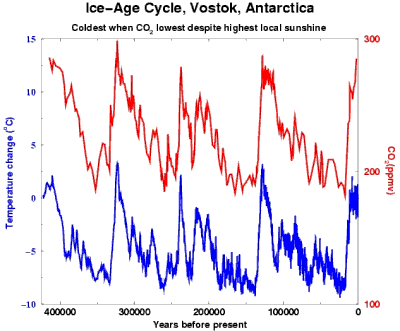
Vostok Ice core, called proxy data, showing the relation between temperature and CO2 over time.
”some impacts are more subtle though. Changes in phenology, the timing of natural events, can illuminate the trends in US ecosystems.”
i. “Virginia bluebell is flowering seventeen days earlier than bluebells would have a few decades ago.”
ii. Pine bark beetle infestations of white pine in Yellowstone, due to warmer winters and longer growing season.
p. 36
2.
Changes in the North (Arctic)
“. . .patchier and thinner sea ice coupled with rising air and water temperatures are shifting the northern Bering Sea habitat to conditions usually found farther south. The native fish and other animals that the Inuit depend on for their subsistence and lifestyle are getting harder to find.”
p. 65.
“Each of the components of the polar fabric has a global connection. The extent of the sea ice affects planetary reflection of sunlight, the circulation of the world ocean, and the global transport of goods. The storage of water in glaciers affects sea level worldwide: the carbon stored in permafrost or sequestered in the deep ocean affects the global concentration of greenhouse gases; the resources such as fisheries, timber, minerals, and fuel sustain populations and development around the world.”
“what happens …affects us all.”
p. 69.
3. SEA CHANGES There are 500 billion tons of CO2 in the ocean 73
Floating duckies
74
density of sea water
changes in density drive circulation up and down in deep and surface currents
Thermohaline circulation as sea is diluted by fresh water from Greenland ice melt
74
Ocean absorbs and sequesters heat
“The enormous heat capacity of the ocean means that changes in the atmosphere take a long time to affect the ocean.”
Oceans are 20 times more thermically energized than is the air
75
Oceans are changing
75-76
El nino changes – more frequent
La nina As SO Oscillation
SEA LEVEL
East side of gulf stream is higher than the Fla side
Local sea level changes El Nino
Versus
Eustatic changes
Volumetric increase = Ocean Thermal Expansion
“And as long as the ocean continues to warm, the rise will continue. Given the long timescales for reaching the deep ocean, this fact implies that sea levels will continue to rise for centuries after atmospheric temperatures have stabilized.”
77
mm rise / year
.05 baseline -- pre warming
2. past
3. now
Ocean thermal expansion accounts for half the rise, melting land glaciers the other.
4 to 8 inches in a century
OCEAN CHEMISTRY
Acid quality of increasing, salinity and nutrients
78
“Roughly one-third of the al the co2 created by fossil fuel burning and other human activities end up in the ocean.
79
ocean acidification 8.2-8.1 pH
79
warm oceans absorb less CO2 driving up the amount in the air.
80
OCEAN BIOLOGY
CORALS
Bleaching – expelling the algae
81
ecosystem (fishery) collapse due to coral die off
difficult to produce calcium carbonate
82
“Bur climate change, at minimum, exacerbates and already serious problem.”
83
FiSHERIES
1997=98 collapse of the California squid fishery due to el nino.
83-84
Orca changed diets from seals and seal ions to sea otters as Aleutians warmed
ESTUARIES AND COASTAL REGIONS
85
increased rate of coastal erosion
subsidence
Miss Delta and Venice
86
OCEAN SURPRISES
Methane clathrates or hydrates frozen at depth and pressure
88
Warming could release the
89
uncertainties point to how little the ocean is understood.
89
4. GOING TO EXTREMES [Abrupt climate change] 95
a shift “Toward a different average state”
“We experience the climate through weather.”
90
TROPICAL CYCLONES
91
“We keep putting more infrastructure in harm’s way along the coasts”
101
DROUGHTS
SAHEL – Africa 1970s & 80s
102
models and the sea surface temperatures related to the SAHEL drought and drying up of Lake Chad
103
“was in part caused by anthropogenic emissions.”
104
American southwest droughts
Dust Bowl 1930s (mild but persistent La Nina conditions.”
105
sub tropical dry zones get larger as the storm tracks shift pole ward
“shifts may be to a permanently drier state.”
106
FLOODS
Greater intensity of storms due to increased humidity at warmer temperatures
107
“Analyses have shown that the amount of rain falling in the most intense downpours has increased faster than mean rainfall amounts over the last thirty years.”
108
HEAT WAVES & COLD SNAPS
“As the planet gets warmer, there will be more heat waves, and worse ones.”
Pine bark beetle infestations – moving north due to a lengthening of the growing season and delay of the cold, which inhibits the beetle.
109
• increase droughts
• heat waves
• intense rainfall events
“may have already been detected in observations.”
111
Threats
to biotic diversity 113
ORDER AND STRUCTURE in THE BIOSPHERE
115
CLIMATE CHANGE & BIODIVERSIY
118
CHANGES IN SPACE AND TIME
119
HUMANS AND CHANGING BIODIVERSITY
125
BIOSPHERIC MELTDOWN
128
The absence of red, blue and ultra-violet reflection from the earth due to the planet and the stratosphere absorbing UV
113
The biosphere absorbs red and blue bands of the spectrum
114
1000 billion tons is the combined weight of all living things on earth
move billions of tons of elements, compounds and materials among the Earth’s spheres every.
114
“They do this using chlorophyll—an incredible protein that can collect energy across the visible spectrum”
“The biosphere has created this environment, and it is this environment that allows the biosphere to persist.”
“The biosphere is undoubtedly a lead character in the climate change drama.”
114
“It is the biodiversity of life that truly astonishes.”
There are “between 10 and 30 million different species.”
ORDER AND STRUCTURE
in THE BIOSPHERE
114
an organism unit that breeds true for many generations.”
115
“mesmerized by life’s extraordinary variety”
115
“Earth’s diversity defies easy description.”
“Life is surprisingly ordered.”
“the banded pattern of biomes, the major climate-controlled ecosystem types.”
116
ORDER AND STRUCTURE
in THE BIOSPHERE continued
“biodiversity has helped to create the earth’s anomalous climate, but climate governs the well-ordered patterns of distribution and abundance …on Earth.”
117
“Climate and biodiversity are thus inextricably linked.”
117
“This envelope of conditions is what ecologists refer to as niche….”
“A Second key is that temperatures, moistures, and other environmental factors . . .are very diverse.”
“The third point… is that biodiversity is structured.”
117
CLIMATE CHANGE &
BIODIVERSIY
118
Biological diversity “both contributes to and is affected by climate.”
“Phenology”
“What they have found is staggering. Almost anywhere anyone looks, on average, climate change in recent decades is changing the order and structure of life on Earth.”
118
6000 years ago the Sahara was grassland.
119
“current climate change is occurring very quickly.”
Small differences can have dramatic impacts.”
119
order (where and when) and structure (predator/prey) are adversely affected
CHANGES IN SPACE AND
TIME
119
“When conditions change species either, move, adapt, or perish
Of 1600 species studies up to half have changed their phenology or range in the last 20-140 years.
119
“Unfortunately, the current rate of change is so fast that evolution is not going to be able to catch up.”
120-121
”surprising and worrisome consequences.”
Birds nesting in the Netherlands too late for the peak insect boom on which it feeds pied flycatchers
121
tipping point “Which s a common characteristic of complex ecosystems” as dramatic shifts that derives from often merely slight changes.
121-122
CHANGES IN SPACE AND
TIME continued
119
loss of stability
“So their mismatch in seasonality could spell trouble for the community.”
124
Chytrid fungus and pine bark beetles spread due to new climate conditions.
124
the coral algae polyp relation has been disrupted – affecting ¼ of marine inverts!
124
how sensitive biodiversity is to climate change
125
HUMANS AND CHANGING
BIODIVERSITY
125
“provides ecosystem services”
“supplying provisions that humans need.”
125
Shifts in maple syrup production and tree yields.
pp. 125-127
BIOSPHERIC MELTDOWN
“nature may no longer exist.”
128
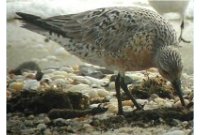 “the effects of climate change are much more haphazard.”
“the effects of climate change are much more haphazard.”
131
“The evidence is overwhelming: the biosphere is changing. The order and structure of its biospheres components, namely its species, are being reconfigured. We face a potential biospheric meltdown.”
131
A feeding Red Knot; the birds are migratory and are an estuarine dependent indicator of abrupt climate change.
6 CLIMATE DRIVERS
135
"The Earth is currently warming."
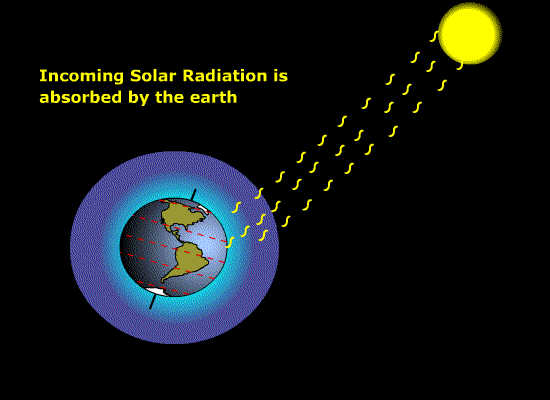
solar radiation -- flux of
"infrared from the surface is absorbed by greenhouse gases, heating up the atmosphere."
137
"clear signs of human activity changing the composition of the atmosphere.
137
"This may not
sound like much, but it is more than 36 percent greater than the 280 ppm at the
dawn of the industrial era."
138
"the radiative forcing concept" GHgases "positive forcing"
"expressed as an energy flow"
139
6 CIMATE DRIVERS continued
135
Radiative forcing "in watts per square meter"
W/m2
36 percent growth in CO2
so far over the industrial era is about 1.5W/m2
139
"How does climate
respond to radiative forcings?"
140
"As the Earth warms,
the air has more capacity to hold more water as vapor"
"Water vapor,...absorbs
additional heat radiating from the surface."
defense discussion treating
water vapor as a feedback and not as a forcing (stimuli, or agent affecting an
initial condition)
142
The natural carbon cycle is
complex."
144
"Anthropogenic carbon
is such an abrupt perturbation to the natural carbon cycle that many components
of climate have not had time to respond and interact with the new carbon."
145
"anthropogenic carbon
budget"
146
"the sink is
partitioned into land and ocean" "ocean
carbon uptake is best"
147
"1.5 to 2.5 gigatons of
carbon [GtC] per year has taken place over the last decade [1998-2008]"
147
"Melting permafrost in
high latitudes may release CO2 and methane currently stored in the
soil."
147-148
"TWO IMPORTANT POINTS
TO ADD"
"1st, CO2
concentrations will take decades and centuries to come back down"
"2nd, simply
stabilizing CO2 at the concentration it is now requires a reduction
in emissions of around 60 percent, and because of climate feed backs, the
reduction may need to be closer to 80 percent in the long term."
148
Thermal Inertia
"...but climate is not
presently in equilibrium:"
"Things are instead
changing quickly, and this fact has important implications for the future.
"This lag of water
(boiling) is thermal inertia, the larger the inertia, the larger the lag." of the water reaching the
ambient air temperature
"Earth's climate system
has considerable inertia."
150
"As heat is added to
the atmosphere, ocean, and land systems due to radiative forcing, the
temperature gradually responds." heats
up
150
"The upper ocean takes
several decades to equilibrate with an increase in heat input."
"if greenhouse gases in
the atmosphere were stabilized now, the Earth’s temperature would continue to
increase, because the oceans are still responding to forcings of several
decades ago."
150
"Attribution
and the nature of 'Proof' "
"Our climate is
unequivocally warming, and it is very likely due to human activity–principally
the emission of greenhouse gases."
151
*
√ The most succinct
paragraphs on human caused warming
¶ 1 -- on "testing of
various possible explanations of global warming"
¶ 2 --
"explanations…make distinct predictions about other observations"
151
"The theory of the
anthropogenic role in global warming is" = theories of gravity --plate tectonics
-- evolution
151
"Climate researchers
have a simple reason to think that humans play a dominant role in warming . .
.. spatial variation and
'fingerprints' can be matched reasonably well."
152
"When only the natural
forcings are used, the temperature evolution can not be reproduced, especially
the rapid warming after 1970. Conclusions have not been reached simply because
of lack of imagination in thinking of other explanations."
"But when applied to
the current climate change, these theories are inadequate."
"explanations bases on
solar activity fail, because observed solar variations have shown no trend in
recent decades."
"Warming due to
anthropogenic greenhouse gases is the best explanation for current trends, it
has survived many tests, and it has no viable competitor."
152
The
Scientific consensus on climate change
153-55
"In the late 1970s
scientists realized that increased greenhouse gases would lead to global
warming and the consequences could be grave."
153
7, Studying Climate Da
Vinci & Thoreau
157-177
"One of the most complex and lively branches in
all of Earth science."
157
Observing climate processes is
climatology
158
"fundamental studies on
how the reflectivity of the snow and ice changes as a function of temperature
and surface conditions, and how clouds and sea ice interact to control the heat
balance of this crucial component of the climate system."
161
four branches of the climate
science division of the Earth sciences
1. climatologists and meteorologists
2. reconstructing paleo-climates
3. tracking ecosystem changes
4. modelers
160-175
"These empirical formulas are called
parameterizations. The uncertainty in these formulas accounts for a lot of the
differences between the models."
171
"much of the
interesting behavior of the climate system is emergent. For instance we have no formula for
modeling a midlatitude storm track across North America, yet all models show
one."
171-72
"The models are not
perfect." "This
makes it difficult to model El NiĖo events properly and gives rise to
systematic biases in tropical rainfall."
"the models give very
consistent answers for how sensitive climate is to increases in greenhouse
gases or to the spatial patterns of ocean temperature variations."
173
"generate new
ideas that can be tested against observations."
173
"Ocean mud accumulates year after year and can provide information about past climate."
174
"Current GMCs (Global Climate Models) assume that the response times for ice sheets are centuries or longer and so, historically, they have not included a dynamic ice sheet component."
176
"they know how interconnected the climate system is. They also know that the answers we need are often only be sought in inaccessible, cold, dirty and difficult environments."
177
analyzing tree rings from trees uncovered by the Columbia glacier's retreat in Alaska and measuring lake ice thickness on Lake Mendota in Wisconsin
178.
"lowly bryophytes ...can be sensitive indicators for alpine change."
178-179
 Wallace S. Broecker, on the "the nature of abrupt climate
change"
Wallace S. Broecker, on the "the nature of abrupt climate
change"
humanity should be extremely wary of 'prodding the climate beast.' "
179
8, The Prognosis for
Climate Niels
Bohr -- accuracy
195-209
"A clear need to
explain the implications of our scientific understanding for future
climate."
195
the medical analog
195
"global mean
temperature predictions" based on forecast, predictions, projections"
"• high
• medium
•
low emission futures" –or what if scenarios
196
"The IPCC projections
are not forecasts."
two things:
1. the forced or driven
response, which is to a large extent predictable, and
2. the unforced weather
component -- storms, ocean currents, volcanic--"which is
contingent..."
197
"The price we pay for
not being able to do this modeling at the moment is today's projections are
only good for average changes over the long term and not for the next season or
next year."
197-98
"describe the change in external
conditions."
198
"climate impacts under
any particular scenario are closely tied to the temperature change."
199
"The worst and best
cases cannot simply be dismissed as outliers. Sensible policymaking needs to
factor in these possibilities as well."
uncertainty is due" to
either 1) the scenarios counting on technology, 2) climate model uncertainty.
199
9, Getting our
Technological Fix Holmes
& Watson
213-234
America’s fuel options are, currently, coal for
electricity and oil for transportation.
Is that a wise energy policy?
• The nation imports more than half of our oil
and has since 1960.
• Coal is subsidized
“In general there are three basic ways to do
this: one can improve energy efficiency, use emission-free energy sources
(renewable), or prevent emissions from reaching the atmosphere (carbon capture
and storage).”
p.
214
“Mitigation strategies” “to moderate, or
make less severe.”
p.
214-15.
Life cycle analysis
“This type of analysis is a useful tool for
comparisons between products.”
215
A bcorn ethanol “is actually worse than
gasoline.”
215
The
Energy Portfolio
216
Energy
Efficiency
217
Renewable
Energy
220
Carbon
Capture and Storage
224
“Currently, 86 percent of the primary energy
consumption is derived from fossil fuels, the source of most greenhouse gases.”
p.
224.
Mobile
Sources of Carbon
227
Other
Greenhouse Gases
228
Geo-engineering
230
Solving the Problem one wedge at a time
233
“For some final thoughts on renewable energy
systems, lets return to the laws of thermodynamics which clearly state that you
can’t get something for nothing, and in fact, you’re lucky if you get even
close.”
“The production of electrical energy must
result in the removal of another form of energy from somewhere else.”
At the other end, wherever electricity is used,
heat is released.”
“Given our current urban environment, solar
roof panels may result in the smallest net changes. These effects of renewable
energy sources may eventually need to be compared with the (usually much larger) effects of
resource extraction.”
p. 223
Carbon Capture and
Storage
“Currently, 86 percent of the primary energy
consumption is derived from fossil fuels, the source of most greenhouse gases.”
p. 224.
“…technologies for carbon capture and storage
would increase the cost of producing electricity by 20 to 100 percent.”
p. 227.
Other Greenhouse Gases
“Passive systems can also remove trace
pollutants in ways that are barely noticeable.“
“Titanium dioxide has the ability to
absorb ultraviolet radiation . . . . operate without energy inputs.”
229
Solving the Problem one
wedge at a time
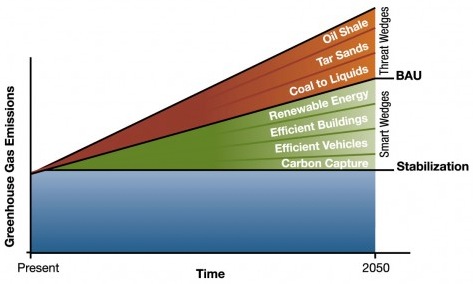
These wedges are ways to alter or impede policies; BAU means business as usual.
“Mitigating climate change is a complex
problem, that can seem overwhelming.”
“Each grouping of technological solutions, such
as renewable power and efficiency, constitute a wedge.”
233
“If our goal is to produce a sustainable
society, then to a certain extent, we will eventually need to mimic natural
systems.”
“waste is food,” or “cradle to cradle”
“Within the forest, little of that material is
wasted, and much is recycled to the benefit of the few seedlings that
germinate.”
“installment of small scale renewable
energy systems seems a promising path.”
“save us from more drastic solutions.”
234
"If our goal is to produce a sustainable society, then to a certain extent, we will eventually need to mimic (and possibly enhance) natural systems."
"The general idea is to move toward a zero waste society. A flowering tree provides an apt analogy...an abundance of flowers and seeds that interact with the entire forest."
"Within the forest little of that material is wasted, and much of it is recycled."
p. 234.
"the ubiquitous [1]installment of small-scale renewable energy systems seems a promising path."
"These could save us from more drastic solutions."
p. 234.
10, Preventative
Planetary Care Tony Blair 251-275
The focus on international climate talks
"The tragedy of the commons clearly applies to the climate change problem–the benefit from using fossil fuels goes to the users, while the costs are paid by the entire world"
Sir Nicholas Stern: "a colossal market failure."
252.
UNFCCC Climate Treaty 1992 -- 190 signatories Rio Earth Summit
Climate on the Hill
& Final Note: 276-280
6/7/12 2:17 PM
